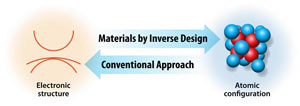
Handy Links
SLAC News Center
SLAC Today
- Subscribe
- Archives: Feb 2006-May 20, 2011
- Archives: May 23, 2011 and later
- Submit Feedback or Story Ideas
- About SLAC Today
SLAC News
Lab News
- Interactions
- Lightsources.org
- ILC NewsLine
- Int'l Science Grid This Week
- Fermilab Today
- Berkeley Lab News
- @brookhaven TODAY
- DOE Pulse
- CERN Courier
- DESY inForm
- US / LHC
SLAC Links
- Emergency
- Safety
- Policy Repository
- Site Entry Form

- Site Maps
- M & O Review
- Computing Status & Calendar
- SLAC Colloquium
- SLACspeak
- SLACspace
- SLAC Logo
- Café Menu
- Flea Market
- Web E-mail
- Marguerite Shuttle
- Discount Commuter Passes
-
Award Reporting Form
- SPIRES
- SciDoc
- Activity Groups
- Library
Stanford
Around the Bay
SSRL to Aid New Energy-Research Center
The Stanford Synchrotron Radiation Lightsource at SLAC will play a key role in a new effort to make solar power more efficient and inexpensive.
SSRL will contribute to the Center for Inverse Design, or CID, a project headed by the Department of Energy's National Renewable Energy Laboratory in Golden, Colorado. CID is one of 46 DOE-funded Energy Frontier Research Centers. The EFRCs, announced by the White House April 27, will investigate ways to wean the U.S. energy economy off fossil fuels.
As its name suggests, CID will take an unconventional approach to materials design. Traditionally, scientists looking for materials or structures with certain properties—such as highly efficient solar cells— empirically test many possibilities before finding something suitable. Instead of relying on such trial-and-error methods, CID will use quantum theory and powerful computers to identify and design materials with the desired properties and—in favorable cases—synthesize them in the lab.
"The goal is to fundamentally change the way we make materials," said SLAC physicist Michael Toney, one of CID's 12 principal investigators and supervisor of its work at SSRL.
CID officially starts operations August 1 and will run for at least five years. Researchers at NREL, Northwestern University and Oregon State University will identify better ways to build a solar cell, analyzing every component from its transparent conducting coating to its substrate backing. SSRL will help vet the resulting materials and structures, testing and characterizing them via photoemission spectroscopy, X-ray absorption spectroscopy and X-ray diffraction.
In addition to its applications for solar power development, the Center's work has the potential to revolutionize materials design. Its untraditional approach could be used for any project that requires specialized materials.
CID is not the only EFRC with SLAC involvement. Centers based at Oak Ridge National Laboratory in Tennessee and Stanford University are also employing SLAC facilities or expertise.
And Toney said he thinks SSRL's contributions will not be limited to the Center for Inverse Design.
"I'm positive we'll be helping other EFRCs out," he said.
—Michael Wall
SLAC Today, June 8
